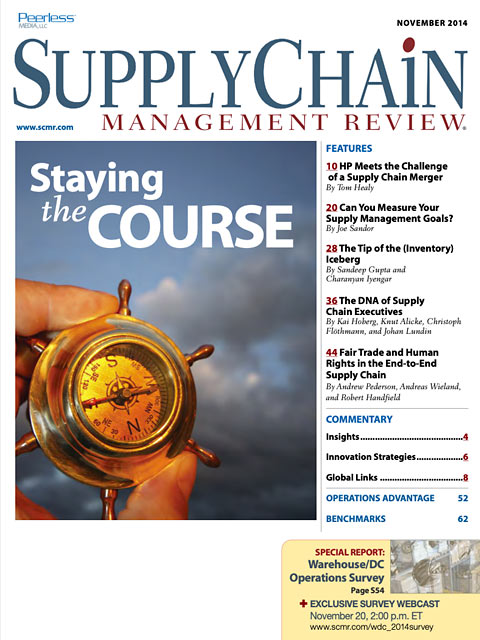Sorry, but your login has failed. Please recheck your login information and resubmit. If your subscription has expired, renew here.
November 2014
Supply chain managers are on the lookout for metrics that will allow them to put a number to their progress - or lack thereof. Welcome to KPI's that allow them to demonstrate the quantifiable value that they deliver. At the same time, Murphy's Law may intervene or they may be called upon to put out fires or come to the rescue and make good on the promises sales and marketing have made to customers - regardless of the cost. So, how do you measure success? I hope this month's issue and online bonus feature help you consider how you measure your progress. Browse this issue archive.Need Help? Contact customer service 847-559-7581 More options
By now, all major multinational companies understand that their cost structure is dominated by what they spend on purchased goods and services. Further, an increasing number of firms recognize the opportunity from the sheer size of outside spend relative to the cost of goods sold (COGS) plus the historically limited attention to the supply function. When these two factors—size and neglect—are combined, it becomes evident that improved supply management may be the best way to improve overall competitiveness. Accordingly, supply management leaders are articulating grand visions for supply management that I refer to as “illustrative goals.” The most common are:
be the Customer of Choice (CoC);
deliver an absolute and Sustainable Competitive Advantage (SCA); and
- be an Indispensable Business Partner (IBP).
I call these goals illustrative for three reasons. First, no one ever really expects them to be completed or the goal to be fully reached. Second, there is rarely a “hard number” attached to them. Third, they seem to have the flavor of a moral platitude as opposed to a well-defined objective—like cod liver oil, they must be good for your organization.
Although few organizations assign a metric to track their success, these illustrative goals have grown steadily more ambitious as supply management has increased its scope and organizational influence. Still, for these goals to be more than moral platitudes, we must be able to measure our progress.
 |
This complete article is available to subscribers
only. Click on Log In Now at the top of this article for full access. Or, Start your PLUS+ subscription for instant access. |
SC
MR
Sorry, but your login has failed. Please recheck your login information and resubmit. If your subscription has expired, renew here.
November 2014
Supply chain managers are on the lookout for metrics that will allow them to put a number to their progress - or lack thereof. Welcome to KPI's that allow them to demonstrate the quantifiable value that they… Browse this issue archive. Access your online digital edition. Download a PDF file of the November 2014 issue.
 |
Download Article PDF |
By now, all major multinational companies understand that their cost structure is dominated by what they spend on purchased goods and services. Further, an increasing number of firms recognize the opportunity from the sheer size of outside spend relative to the cost of goods sold (COGS) plus the historically limited attention to the supply function. When these two factors—size and neglect—are combined, it becomes evident that improved supply management may be the best way to improve overall competitiveness. Accordingly, supply management leaders are articulating grand visions for supply management that I refer to as “illustrative goals.” The most common are:
be the Customer of Choice (CoC);
deliver an absolute and Sustainable Competitive Advantage (SCA); and
- be an Indispensable Business Partner (IBP).
I call these goals illustrative for three reasons. First, no one ever really expects them to be completed or the goal to be fully reached. Second, there is rarely a “hard number” attached to them. Third, they seem to have the flavor of a moral platitude as opposed to a well-defined objective—like cod liver oil, they must be good for your organization.
Although few organizations assign a metric to track their success, these illustrative goals have grown steadily more ambitious as supply management has increased its scope and organizational influence. Still, for these goals to be more than moral platitudes, we must be able to measure our progress.
 |
SUBSCRIBERS: Click here to download PDF of the full article. |
SC
MR

Latest Supply Chain News
- Technology’s role in mending supply chain fragility after recent disruptions
- Tech investments bring revenue increases, survey finds
- Survey reveals strategies for addressing supply chain, logistics labor shortages
- Israel, Ukraine aid package to increase pressure on aerospace and defense supply chains
- How CPG brands can deliver on supplier diversity promises
- More News
Latest Podcast

 Explore
Explore
Latest Supply Chain News
- Technology’s role in mending supply chain fragility after recent disruptions
- Tech investments bring revenue increases, survey finds
- Survey reveals strategies for addressing supply chain, logistics labor shortages
- Israel, Ukraine aid package to increase pressure on aerospace and defense supply chains
- How CPG brands can deliver on supplier diversity promises
- How S&OP provides the answer to in-demand products
- More latest news
Latest Resources

Subscribe

Supply Chain Management Review delivers the best industry content.

Editors’ Picks





